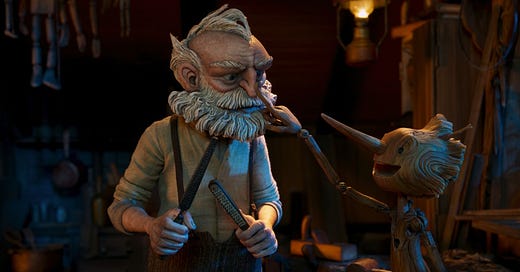Guillermo del Toro's Pinocchio
The new stop-motion animation version is a decidedly dark reimagining of the classical tale that gradually worms its way into your heart.
After halfway into “Guillermo del Toro's Pinocchio,” I was feeling dazzled by the amazing stop-motion animation but a little emotionally disconnected from the tale. It’s a decidedly dark reimagining of the classical story, somehow managing to include all the story elements we’re familiar with but giving everything a quarter-turn toward the macabre, as is the Mexican filmmaker’s wont.
Know how your phone will suddenly go into night mode without warning, and you can still find everything but the transition is weird and disorienting? It’s like that.
Eventually the film found its way, or I did, and we met for a very satisfyingly conclusion that evoked not a few genuinely wet tears. I always say it’s better for a movie to start slow and gain steam as it goes rather than the other way 'round, and this “Pinocchio” certainly does that.
If you’re wondering about the expansive title: that’s to differentiate this one from the version starring Tom Hanks that came out on Disney+ just a few short months ago, which got pretty well ravaged by most critics but not me.
(What can I say, I’m getting soft-hearted in my dotage.)
I like del Toro’s version a bit more, despite the early hollowness. It’s more ambitious and even in some ways grand, and so hauntingly beautiful that you could snip just about any frame out of the film — rhetorically speaking; it’s all digital now — blow it up and hang it on the wall, and it would not look out of place.
It also boasts some surprisingly puckish humor and sharp violence that push the edges of its PG rating from MPAA. I think it’s fine for most children, though those kindergarten and below may need a comforting squeeze from time to time.
del Toro shares screenwriting duties with Patrick McHale, plus a story credit goes to Matthew Robbins, and stop-motion veteran Mark Gustafson serves as co-director.
The look and feel of the movie was inspired by Gris Grimly’s 2002 illustrated update of the 1883 novel “The Adventures of Pinocchio” by Carlo Collodi, which of course was the basis for the 1940 Disney animated film that set the benchmark for the character — which this version veers so sharply away from.
First off, you’ll notice that Pinocchio looks less like a polished, lifelike puppet and more like raw chunks of wood haphazardly hammered together. He’s got one ear, a hole in his chest, hollows for eyes, nails sticking out of his nape and a root randomly protruding from his head.
Let’s be blunt: he’s kinda scary, like he could have sashayed over from “The Nightmare Before Christmas.”
That’s because in this iteration of the legend, woodworker Geppetto (voice of David Bradley) is not kindly and selfless, but a dyspeptic old drunk who cannot stop mourning the loss of his beloved son, Carlo, during World War I, as a lengthy and heartrending prologue shows. The rest of the story happens about 20 years later as the arm of fascism envelops Italy in the grasp of Mussolini.
In a drunken fit, Geppetto chops down the pine tree he had planted next to Carlo’s grave, which had recently become inhabited by a Sebastian J. Cricket (Ewan McGregor), a wandering blue insect who was looking for a place to settle down and write his memoirs. Instead, his new home winds up inside Pinocchio’s chest, so Sebastian serves (almost) literally as his heart.
Taking pity on Geppetto, the Wood Sprite (Tilda Swinton) grants his wish to bring Pinocchio to life. At first, Geppetto is horrified, especially by the wooden boy’s ferocious curiosity about everything that’s new to him, and his impish refusal to obey his papa. It’s not so much that Pinocchio is defiant; he’s just powerfully naïve and easily distracted.
Eschewing school and its boring “mathtemanticks,” he winds up in the circus of Count Volpe (Christoph Waltz), a greedy villain whose only companion is a grungy monkey, Spazzatura, who works the marionette strings and is voiced, most unexpectedly, by Cate Blanchett.
Further adventures find Pinocchio sent off to boys’ military school along with Candlewick (Finn Wolfhard), the son of local fascist leader Podestà (Ron Perlman), and of course being swallowed by a sea leviathan.
Sebastian — don’t call him Jiminy — acts as our narrator, never once utters the word “conscience” and repeatedly attempts to break into song, only to have it foiled by various happenings.
Stick around for the credits, when he finally gets a reprise — it’s worth it.
He’s not the only one to sing. Gregory Mann, who does the voice of Pinocchio, has a high, sweet tone well exploited by composer Alexandre Desplat over several tunes, especially “Ciao Papa,” an ode to Geppetto that del Toro helped write. It’s not a wall-to-wall musical, but the songs happen just often enough to comment upon and carry the story forward rather than bringing everything to a halt.
As I say, all the bones of the Pinocchio fable are there — just rearranged, tilted and turned to the spooky side. For example, there’s an underworld that Pinocchio visits several times, where the sphynx sister to the Wood Sprite (also voiced by Swinton) holds dominion over the dead, who are carried away by rabbit pallbearers who play poker in their downtime.
Even if it’s obsessed with darkling imagery and themes, this “Pinocchio” still has plenty of whimsy and joy to share. Like Sebastian settling into the puppet’s chest, Guillermo del Toro's iteration will eventually worm its way into your heart.






I want to see this!! Thanks for your review!!!